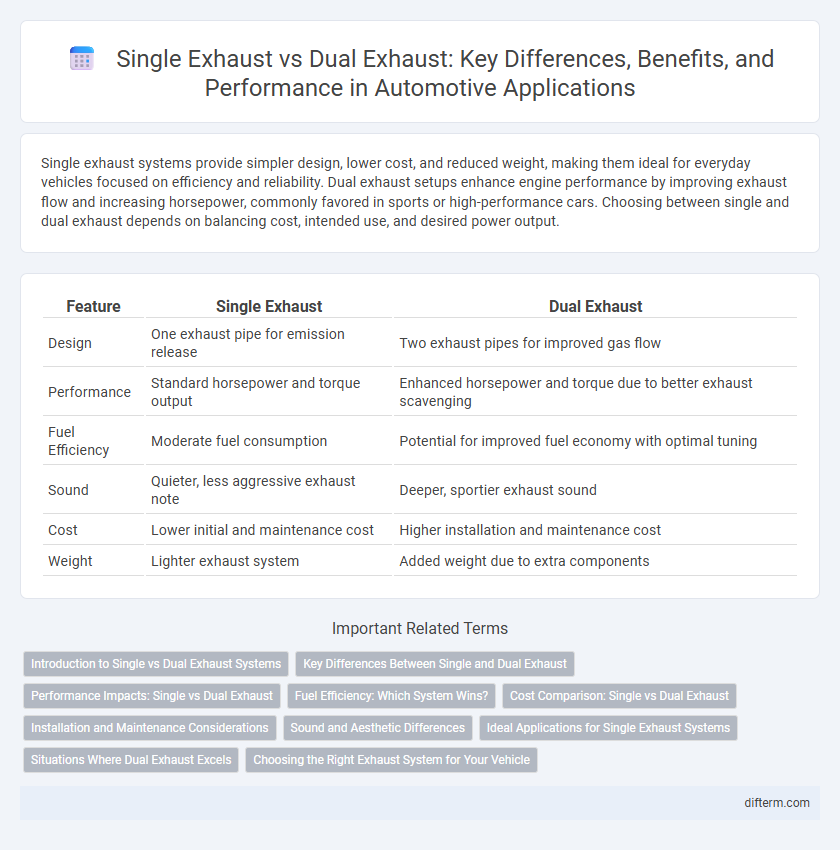Single exhaust systems provide simpler design, lower cost, and reduced weight, making them ideal for everyday vehicles focused on efficiency and reliability. Dual exhaust setups enhance engine performance by improving exhaust flow and increasing horsepower, commonly favored in sports or high-performance cars. Choosing between single and dual exhaust depends on balancing cost, intended use, and desired power output.
Table of Comparison
| Feature | Single Exhaust | Dual Exhaust |
|---|---|---|
| Design | One exhaust pipe for emission release | Two exhaust pipes for improved gas flow |
| Performance | Standard horsepower and torque output | Enhanced horsepower and torque due to better exhaust scavenging |
| Fuel Efficiency | Moderate fuel consumption | Potential for improved fuel economy with optimal tuning |
| Sound | Quieter, less aggressive exhaust note | Deeper, sportier exhaust sound |
| Cost | Lower initial and maintenance cost | Higher installation and maintenance cost |
| Weight | Lighter exhaust system | Added weight due to extra components |
Introduction to Single vs Dual Exhaust Systems
Single exhaust systems feature one exhaust pipe that directs gases from the engine, optimizing weight and cost for standard vehicles. Dual exhaust systems use two separate pipes to improve exhaust flow, enhance engine performance, and deliver a more aggressive sound, typically found in high-performance or sports cars. Choosing between single vs dual exhaust depends on priorities such as fuel efficiency, horsepower, and vehicle design.
Key Differences Between Single and Dual Exhaust
Single exhaust systems feature one pipe and are typically simpler, lighter, and more cost-effective, providing adequate performance for standard vehicles. Dual exhaust systems utilize two pipes, allowing better airflow, increased engine efficiency, and higher horsepower, especially in performance-oriented cars. The primary differences lie in exhaust flow capacity, sound amplification, and potential fuel economy improvements associated with dual exhaust setups.
Performance Impacts: Single vs Dual Exhaust
Single exhaust systems generally provide adequate performance for everyday driving by allowing exhaust gases to exit through one pipe, which can limit the flow rate and reduce engine efficiency at high RPMs. Dual exhaust systems improve performance by enabling better exhaust flow, lowering backpressure, and increasing horsepower and torque, especially in high-displacement or performance engines. Vehicles equipped with dual exhausts often experience enhanced throttle response and more efficient combustion due to improved scavenging effects.
Fuel Efficiency: Which System Wins?
Single exhaust systems generally provide better fuel efficiency due to reduced weight and simpler design, minimizing exhaust backpressure for most everyday driving conditions. Dual exhaust systems, while enhancing engine performance and power in high-performance vehicles, often result in slightly lower fuel economy due to increased exhaust flow complexity. Fuel efficiency advantages of single exhausts are more pronounced in small to mid-sized engines, whereas dual exhausts may be preferred in larger, high-output engines despite their marginal fuel consumption penalties.
Cost Comparison: Single vs Dual Exhaust
Single exhaust systems generally cost less upfront and require simpler maintenance due to fewer components, making them budget-friendly for standard vehicles. Dual exhaust systems, while more expensive initially and in upkeep, offer better performance benefits that can justify higher costs for enthusiasts and high-performance cars. Cost differences are influenced by materials, labor, and vehicle compatibility, with dual exhaust upgrades often exceeding single exhaust prices by 30% to 50%.
Installation and Maintenance Considerations
Single exhaust systems offer easier installation and lower maintenance costs due to fewer components and simpler routing, making them suitable for budget-conscious vehicle owners. Dual exhaust setups require more complex installation, often demanding professional expertise and additional hardware, but they provide improved exhaust flow and performance benefits. Regular maintenance of dual exhaust systems involves monitoring both pipes for leaks and corrosion, which can increase upkeep compared to single exhaust configurations.
Sound and Aesthetic Differences
Single exhaust systems typically produce a deeper, more subdued sound, enhancing a vehicle's classic and refined auditory profile, while dual exhausts generate a louder, more aggressive tone that appeals to performance enthusiasts. Aesthetically, single exhaust offers a streamlined, minimalist rear appearance, contrasting with the sporty and symmetrical look of dual exhaust setups that emphasize power and style. Sound frequency and intensity directly correlate with exhaust design, influencing the vehicle's overall character and road presence.
Ideal Applications for Single Exhaust Systems
Single exhaust systems are ideal for smaller vehicles and daily drivers prioritizing fuel efficiency and lower emissions. These systems provide sufficient exhaust flow for engines with less power output, optimizing performance without added complexity. They are commonly used in compact cars, sedans, and light-duty trucks where space and cost efficiency are critical.
Situations Where Dual Exhaust Excels
Dual exhaust systems excel in high-performance vehicles requiring improved engine efficiency and increased horsepower by allowing exhaust gases to exit more freely, reducing back pressure. They enhance engine sound quality and provide better balance in exhaust flow, which is particularly beneficial in sports cars and trucks designed for towing or heavy loads. Dual exhaust also aids in improved fuel economy during aggressive driving conditions by optimizing the engine's breathing capacity.
Choosing the Right Exhaust System for Your Vehicle
Selecting the right exhaust system depends on your vehicle's engine size, performance goals, and fuel efficiency needs. Single exhaust systems offer cost-effective solutions with simpler installation and adequate performance for smaller engines, while dual exhaust systems enhance horsepower and improve exhaust flow, ideal for high-performance or larger engines. Consider factors such as sound preference, maintenance costs, and emission regulations to ensure the exhaust system matches your driving style and vehicle specifications.
single exhaust vs dual exhaust Infographic

 difterm.com
difterm.com